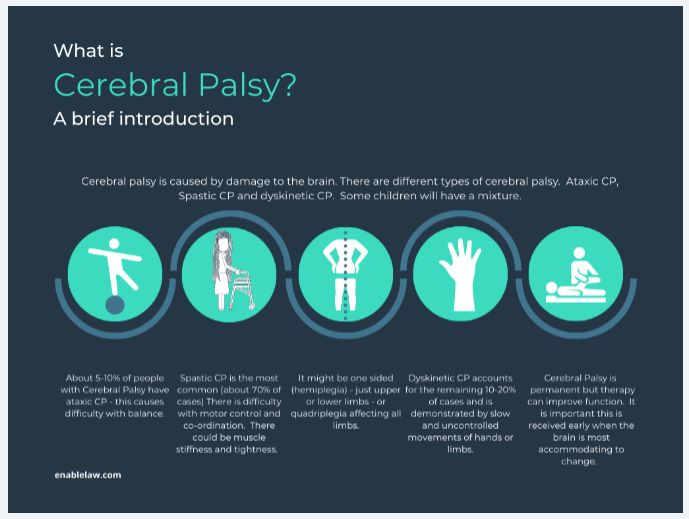If your child has just been diagnosed with Cerebral Palsy (CP) you may be wondering 'what does this mean?' Or you may wonder if your child has CP because of problems that they are having. This is a basic guide to explain Cerebral Palsy.
There are different types of cerebral palsy. Ataxic CP, Spastic CP and dyskinetic CP. Some children will have a mixture
Ataxic CP is where there is difficulty with balance. About 5-10% of children with CP have ataxic CP. This can affect how your child walks and can affect their balance. It is caused by difficulty co-ordinating muscles, Children with ataxic CP may walk with their feet spread apart or their walk may look unbalanced or jerky.
Spastic CP is the most common (about 70% of cases) and is where there is difficulty with motor control and co-ordination. There could be muscle stiffness and tightness. It might be one sided (hemiplegia) just upper or lower limbs or quadriplegia affecting all limbs.
Dyskinetic CP accounts for the remaining 10-20% of cases and is demonstrated by slow and uncontrolled movements of hands or limbs. There can be sudden and extreme changes in muscle tone and posture. Dyskinetic CP is often accompanied by learning difficulties and epilepsy.
Children with any type of CP can also have other difficulties such as vision, behaviour and learning problems.
Cerebral Palsy is a permanent condition which cannot be cured but therapy input can improve function. It is important that this input is received early when the brain is most accommodating to change. Charities such as The Pace Centre provide support to allow children with CP to maximise their potential. We support both The Pace Centre and Action CP with their aims of supporting children with cerebral palsy to access early intervention.
Cerebral palsy is caused by damage to the brain. A child might be diagnosed with cerebral palsy from a parental description and an examination. Sometimes there will be further investigations such as scans (MRI, CT or, in very young babies, ultrasound scans).
Sometimes other investigations such as blood tests will be undertaken to rule out genetic conditions which might need different treatment.
Cerebral Palsy can range from mild to severe. Some children with CP progress to compete in the Paralympics and live fulfilling independent lives. Others will need fulltime care and support throughout their lifetime.
Cerebral Palsy can be caused by many different circumstances. In the western world where there is access to good healthcare approximately 10% of cases are due to lack of oxygen at birth.
Prematurity and infection are also causes of cerebral palsy as are some congenital abnormalities as are multiple pregnancies, untreated maternal hypothyroidism. Other causes include placental damage prior to labour, placental infection (often following premature rupture of the membranes (PROM) and neonatal causes such as infection and low blood sugar levels.
Many of these causes can be avoided in the western world with appropriate healthcare and monitoring, but not all.
A child with Cerebral Palsy may have lifetime needs which can be expensive. These can include therapies such as speech and language therapy, occupational therapy, physiotherapy. A child with CP might require support or care for many hours of the day. Cerebral Palsy may also lead to a need for aids and equipment such as a wheelchair or adapted accommodation.
If the cerebral palsy has been caused by a medical mistake it might be that a damages award will fund these significant needs.
Jackie Linehan is an expert in dealing with cases for children
and adults with cerebral palsy. She has resolved too many cases to
count giving families the much needed financial support to pay for
input and providing security for the future.
If you think your child has CP as a result of a medical error then
contact us.
The content of this article is intended to provide a general guide to the subject matter. Specialist advice should be sought about your specific circumstances.

